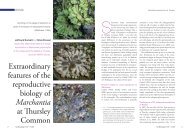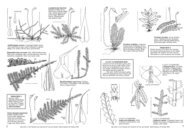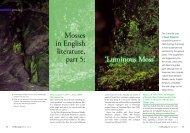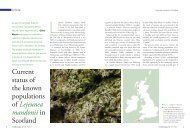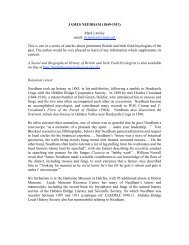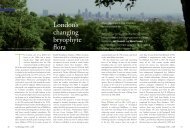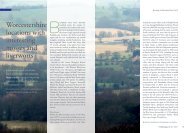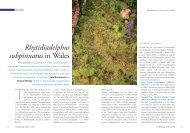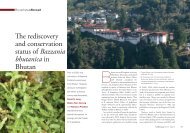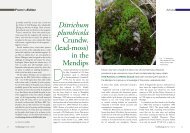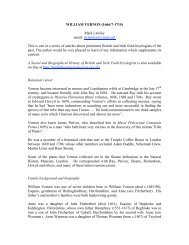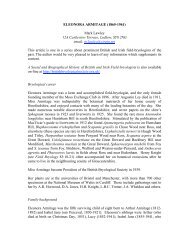Bryological Monograph An annotated checklist of the mosses of ...
Bryological Monograph An annotated checklist of the mosses of ...
Bryological Monograph An annotated checklist of the mosses of ...
Create successful ePaper yourself
Turn your PDF publications into a flip-book with our unique Google optimized e-Paper software.
139. Molecular phylogenies <strong>of</strong> Pottiaceae by Werner et al.<br />
(2004a, 2005b) place <strong>the</strong> European species in <strong>the</strong> three<br />
groups recognized here: Merceyoideae (Scopelophila),<br />
Trichostomoideae (including Splachnobryum,<br />
Ephemeraceae, Pleuroweiseae sensu Corley et al.,<br />
1981, and some Barbula species, e.g. B. bolleana),<br />
and Pottioideae (including Pottieae, Cinclidotus and<br />
Barbuleae sensu Corley et al., 1981). Timmiella does<br />
not belong in Pottiaceae but is listed here until a better<br />
place can be found for it. Likewise, those Barbula<br />
species that belong in Trichostomoideae have been<br />
retained in Barbula until <strong>the</strong>ir correct generic position<br />
can be ascertained.<br />
140. Crumia latifolia (Kindb.) W.B.Sch<strong>of</strong>ield is known<br />
from <strong>the</strong> Caucasus but outside Europe.<br />
141. <strong>An</strong>oectangium handelii is known from <strong>the</strong> Crimea. It is<br />
described by Zander & Weber (2005), correcting an<br />
earlier report by Zander (1977) who had treated it as a<br />
synonym <strong>of</strong> Molendoa sendtneriana.<br />
142. Ephemerum hibernicum was described from Ireland by<br />
Holyoak & Bryan (2005).<br />
143. Holyoak has examined much material <strong>of</strong> Ephemerum<br />
serratum and E. minutissimum, and finds that in both<br />
species occasional plants have leaves with a weak<br />
nerve. He has not seen <strong>the</strong> type <strong>of</strong> E. serratum var.<br />
praecox, which could be a synonym <strong>of</strong> ei<strong>the</strong>r <strong>of</strong> <strong>the</strong>se<br />
taxa.<br />
144. Ephemerum spinulosum has been found in Ireland and<br />
<strong>the</strong> Basque region <strong>of</strong> Spain (Holyoak, 2001; Infante &<br />
Heras, 2005).<br />
145. Author citation for Eucladium verticillatum follows <strong>the</strong><br />
typification by Ochyra & Zijlstra (2005).<br />
146. Gymnostomum mosis (Lorentz) Jur. & Milde was<br />
reported from Spain by Martínez-Sánchez, Ros &<br />
Guerra (1991), but later Cano, Ros & Guerra (1994)<br />
described <strong>the</strong> new species Gymnostomum lanceolatum<br />
based on this material.<br />
147. Gymnostomum aeruginosum var. obscurum was<br />
described by Guerra (2004).<br />
148. Spelling <strong>of</strong> species epi<strong>the</strong>t in Hymenostylium recurvirostrum<br />
follows Hedwig (1801) not Crosby et al.<br />
(1999).<br />
149. Pleurochaete malacophylla (Müll.Hal.) Broth. is listed<br />
for Turkey by Kürschner & Erdag˘ (2005).<br />
150. Splachnobryum delicatulum is treated by Arts (2001) as<br />
a synonym <strong>of</strong> S. obtusum. Splachnobryum obtusum was<br />
not included in <strong>the</strong> main list <strong>of</strong> Corley et al. (1981),<br />
because <strong>the</strong>se authors considered that its occurrences<br />
were not sufficiently natural. However, it occurs in <strong>the</strong><br />
open in Hungary and <strong>the</strong> Azores, and is accordingly<br />
listed here.<br />
151. Tortella arctica (Arnold) Crundw. & Nyholm has been<br />
reported from Svalbard, but <strong>the</strong> records refer to<br />
Trichostomum arcticum (Frisvoll & Elvebakk,1996).<br />
152. Tortella alpicola was reported new for Europe by<br />
Otnyukova et al. (2004).<br />
MOSSES OF EUROPE AND MACARONESIA 233<br />
153. Tortella bambergeri was not recognized as a good<br />
species by Corley et al. (1981), but is generally<br />
accepted by bryologists in central Europe and also<br />
by us.<br />
154. Tortella densa is treated as a variety T. inclinata var.<br />
densa, following Eckel (1998).<br />
155. Tortella limbata has been refound on <strong>the</strong> Canary<br />
Islands. Dirkse et al. (1993) compared <strong>the</strong>ir collection<br />
with <strong>the</strong> holotype and noted <strong>the</strong> distinctive denticulate<br />
leaf border, composed <strong>of</strong> long narrow cells, running<br />
nearly to <strong>the</strong> leaf apex.<br />
156. Tortella limosella is known only from <strong>the</strong> Scottish<br />
type-locality, and has not been refound since its<br />
discovery in 1906.<br />
157. Tortella cirrifolia was synonymized with T. nitida by<br />
Sjögren (2001).<br />
158. Molecular studies by Werner et al. (2005b) show that<br />
<strong>the</strong> genus Trichostomum as listed here is heterogeneous,<br />
with T. brachydontium and T. crispulum nested<br />
within Weissia and T. triumphans very close to<br />
Pottiopsis caespitosa. Trichostomum connivens<br />
(Lindb. ex Broth.) Paris is recorded from <strong>the</strong><br />
Caucasus but is not known from Europe.<br />
Trichostomum contortum (Kunze) Sérgio is probably<br />
a synonym <strong>of</strong> T. brachydontium, although Sérgio<br />
(1985) thought that it was a good species.<br />
159. For synonymy <strong>of</strong> Hyophila treleasei, see Sollman<br />
(1993).<br />
160. Weissia leptocarpa Schimp. ex Besch. is treated by<br />
Sérgio & Carvalho (2003) as a doubtful species, but is<br />
accepted for Turkey by Kürschner & Erdag˘ (2005), in<br />
spite <strong>of</strong> <strong>the</strong> fact that Frey & Kürschner (1991) had<br />
treated it as doubtful and illegitimate.<br />
161. Weissia mittenii (Bruch & Schimp.) Mitt. is omitted,<br />
because it is designated above as a hybrid<br />
W.6mittenii (Bruch & Schimp.) Mitt. emend.<br />
A.J.E.Sm. Smith (pers. comm. to Hill) notes that W.<br />
mittenii has malformed capsules and abnormal spores.<br />
Following Werner et al. (2005b), Astomum is included<br />
in Weissia.<br />
162. A molecular study by Werner et al. (2004b) supports<br />
<strong>the</strong> species status <strong>of</strong> Weissia wimmeriana.<br />
163. Acaulon mediterraneum is treated by many authors as<br />
a variety <strong>of</strong> A. muticum, to which it is undoubtedly<br />
close.<br />
164. Aloina humilis was described from <strong>the</strong> Canary Islands<br />
by Gallego et al. (1998).<br />
165. Aloina obliquifolia is accorded species rank following<br />
Gallego et al. (1999).<br />
166. The Macaronesian Barbula semilimbata Dixon &<br />
Luisier was listed by Eggers (1982) but is a poorly<br />
known taxon, not recorded since it was described.<br />
167. Barbula convoluta var. sardoa is treated by some at<br />
species rank. Frahm & Ahmed (2004a) suggested <strong>the</strong><br />
name B. sardoa. However, <strong>the</strong> epi<strong>the</strong>t sardoa is correct<br />
at <strong>the</strong> varietal level but superfluous at <strong>the</strong> species level.



